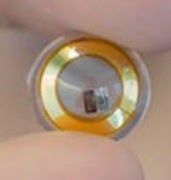Wireless System Design for wearables and the IoT
In quest for developing custom sensors for older adults, we often encounter the challenge of how to relay efficiently data from the sensors to a medical professional. Traditionally, hard-wires were used, but these have their known drawbacks. Using wireless technologies come with tremendous advantages and opportunities. Although there are many available chipsets in market that help with wireless communication, packaging the chipset with the sensors and antennas in small form-factor that does not affect system performance is a challenging endeavor. Our team has presented multiple packaging solutions for various wearables. Many of our solutions are witnessed in commercially available products.Video Link: https://goo.gl/PZ1V8v


Goal:
wireless system design for wearables (smartphones, sensors, smart contact lenses, hearing aids, smart glasses, watches, etc….)

Remote Air Quality/Gas Monitor
Carbon nanotube (CNT) gas sensors have been the subject of extensive research due to their electrical sensitivity to small quantities of gases. In this work, we demonstrated a novel concept system of a low-cost gas sensor utilizing a compact millimeter-wave radar. Characterization of the mm-wave properties of CNTs on paper substrates is performed. When exposed to gas, significant changes in the magnitude of the backscattered signals from the CNT paper sensor can be observed. A compact mm-wave radar was used to interrogate the passive sensors and detect the changes in the backscattered signals, enabling real-time gas monitoring and air quality monitoring. Compared to prior art utilizing RF technologies, this new mm-wave enabled system promises to be of a much higher sensitivity with the potential of being realized at a much lower cost.

Measurement Setup

System Concept
Goal:
Create a portable, low-cost gas sensor for real-time gas monitoring by coupling a wireless sensor with a carbon nanotube-based chemical gas sensing film.
Awards: Hackster Top 10
Non-invasive wireless glucose monitor
How about having a prick-free diabetes monitor? We believe that one solution would be through using wireless sensing. We have developed a prototype system and showed that it is possible to use mm-wave radios to discriminate between various glucose-water concentrations at a high accuracy. We utilized silicone rubber structures and animal meat as human tissue-equivalent phantoms for further validations.
We are currently running a large campaign with various actual blood samples to investigate further the suitability of using our wireless system in non-invasive glucose sensing.
However, it should be stressed that despite having promising preliminary results, this area is still in its infancy, and we believe that there is tremendous research due before non-invasive electromagnetic-based monitoring of diabetes through skin can become a reality. Among the many challenges to address is the fact that scattered electromagnetic energy through skin/blood stream is known to vary with naturally varying physiological parameters such as moisture levels, sweat, temperature, and tissue scarring. Such variations can significantly affect the detection system. Attempts to minimize their impact are part of our ongoing research campaign.
Achieved:
- Proved sensor can differentiate glucose at ranges for diabetes diagnosis (5.7 mmol/L – 7 mmol/L)
- Started clinical tests



Volunteers for the blood collection study
Goal:
To develop a viable solution for rapid, accurate non-invasive real-time monitoring of blood glucose levels
Awards: Best Paper in ACM Mobile Human Computer Interface 2017 - Object Recognition